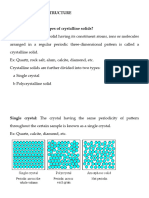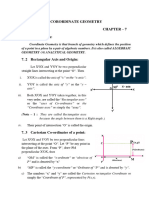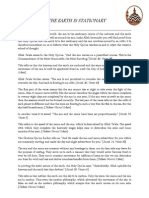Structure and Properties of materials
Uploaded by
fatihakhanam2003Structure and Properties of materials
Uploaded by
fatihakhanam2003Lecture-04
Crystal planes and Miller Indices
(Index system for crystal directions and planes)
Crystal directions:
A crystallographic direction is defined as a line directed between two points, or a vector. We
know that any lattice vector can be written as that given by 𝑇 ⃗ = 𝑛1 𝒂 + 𝑛2 𝒃 + 𝑛3 𝒄. The
direction is then specified by the three integers [𝑛1 𝑛2 𝑛3 ]. If the numbers 𝑛1 𝑛2 𝑛3 have a
common factor, this factor is removed. For example, [111] is used rather than [222], or [100],
rather than [400]. When we speak about directions, we mean a whole set of parallel lines, which
are equivalent due to transnational symmetry. Opposite orientation is denoted by the negative
sign over a number. For example, [01Ī]:
How to find crystal direction:
1. A right-handed x-y-z coordinate system is first constructed. As a matter of convenience,
its origin may be located at a unit cell corner.
2. The coordinates of two points that lie on the direction vector (referenced to the
coordinate system) are determined—for example, for the vector tail, point 1: x1, y1, and
z1; whereas for the vector head, point 2: x2, y2, and z2.
3. Tail point coordinates are subtracted from head point components—that is, x2-x1, y2-y1,
and z2-z1.
4. These coordinate differences are then normalized in terms of (i.e., divided by) their
respective a, b, and c lattice parameters—that is which yields a set of three numbers.
𝑥2 − 𝑥1 𝑦2 − 𝑦1 𝑧2 − 𝑧1
, ,
𝑎 𝑏 𝑐
5. If necessary, these three numbers are multiplied or divided by a common factor to
reduce them to the smallest integer values.
6. The three resulting indices, not separated by commas, are enclosed in square brackets,
thus: [𝑛1 𝑛2 𝑛3 ]. The 𝑛1 𝑛2 𝑛3 integers correspond to the normalized coordinate
differences referenced to the x, y, and z axes, respectively. The n1, n2, and n3 indices
may be determined using the following equations
(𝑥2 − 𝑥1 ) (𝑦2 − 𝑦1 ) (𝑧2 − 𝑧1 )
𝑛1 = 𝑛 , 𝑛2 = 𝑛 , 𝑛3 = 𝑛
𝑎 𝑏 𝑐
Lecture-04 IPE Dr. Ratan C. Gosh
Physics Dept. DU
Examples
Lecture-04 IPE Dr. Ratan C. Gosh
Physics Dept. DU
Crystal planes
The orientation of a plane in a lattice is specified by Miller indices. They are defined as follows.
We find intercept of the plane with the axes along the primitive translation vectors a, b and c.
Let’s these intercepts be x, y, and z, so that x is fractional multiple of a, y is a fractional multiple
of b and z is a fractional multiple of c. Therefore, we can measure x, y, and z in units a, b and
c respectively. We have then a triplet of integers (x y z). Then we invert it (1/x 1/y 1/z) and
reduce this set to a similar one having the smallest integers multiplying by a common factor.
This set is called Miller indices of the plane (hkl). For example, if the plane intercepts x, y, and
z in points 1, 3, and 1, the index of this plane will be (313).
The orientation of a crystal plane is determined by three points in the plane, provided they are
not collinear. If each point lay on a different crystal axis, the plane could be specified by giving
the co-ordinates of the points in terms of the lattice constants a, b, c. A notation conventionally
used to describe lattice points (sites), directions and planes is known as Miller Indices. A crystal
lattice may be considered as an assembly of equidistant parallel planes passing through the
lattice points and are called lattice planes. In order to specify the orientation, one employs the
so-called Miller indices. For simplicity, let us start with a two-dimensional lattice and then
generalized to three-dimensional case.
The equations of plane in 2-D and 3D having the intercepts a, b and a, b, c respectively is
𝑥 𝑦 𝑥 𝑦 𝑧
+ 𝑏 = 1 and 𝑎 + 𝑏 + 𝑐 = 1
𝑎
Crystal direction is the direction (line) of axes or line from the origin and denoted as [111],
[100], [010], etc.
How to find Miller Indices
To determine the indices for the plane P, first we have to find the intercepts with the axes along
the basis vector 𝑎, b, and c. Let these intercepts be x, y, z.
𝑥 𝑦 𝑧
1. Form the fractional triplet (𝑎 , 𝑏 , 𝑐 )
2. Take reciprocal to this set.
3. Then reduce this set to a similar one having the smallest integers multiplying by
common factor.
4. This last set is enclosed in parentheses (h k l), is called the index of the plane or Miller
Indices. The Miller indices specify not just one plane but an infinite set of equivalent
planes. Note that for cubic crystals the direction [hkl] is perpendicular to a plane (hkl)
having the same indices, but this is not generally true for other crystal systems.
Examples of the planes in a cubic system.
Lecture-04 IPE Dr. Ratan C. Gosh
Physics Dept. DU
Example: Determine the Miller Indices of a plane which is parallel to x-axis and cuts
intercepts of 2 and1 2, respectively along y and z axes.
Solution:
i) Intercepts 2b 1/2 𝑐
ii) Division by unit translation ∞/𝑎 =∞ 2𝑏/𝑏=2 c/2(/c) =1/2
iii) Reciprocals 1/∞ 1/2 2
iv) After clearing fraction 0 1 4
Therefore, the required Miller indices of the plane (014)
Example: Determine the M. I. of a plane that makes intercepts of 2Å, 3 Å, 4 Å on the coordinate
axes of an orthorhombic crystal with a:b:c = 4:3:2
Solution:
Here the unit translations are a = 4, b = 3 and c = 2 following the same procedure
i) Intercepts 2 3 4
ii) Division by unit translation 2/4 =1/2 3/3 =1 4/2 =2
iii) Reciprocals 2 1 1/2
iv) After clearing fraction 4 2 1
Therefore, the Miller indices of the plane is (421)
Lecture-04 IPE Dr. Ratan C. Gosh
Physics Dept. DU
Relation between interplanar spacing and Miller indices
Let us consider three mutually perpendicular coordinate axis, OX, OY, and OZ and assume that
a plane (hkl) parallel to the plane passing through the origin makes intercepts a/h, b/k and c/l
on the three axes at A. B and C respectively as shown in figure.
Let OP = dhkl, the interplanar spacing be normal to the plane drawn from the origin and makes
angle α, β, and γ with the three axes respectively.
Therefore, 𝑂𝐴=𝑎/ℎ, 𝑂𝐵=𝑏/𝑘, 𝑂𝐶=𝑐/𝑙
From OPA we get, 𝑐𝑜𝑠𝛼=𝑂𝑃/𝑂𝐴 =𝑑ℎ𝑘𝑙/(𝑎/ℎ), From OPB we get 𝑐𝑜𝑠𝛽=𝑂𝑃/𝑂𝐵 =𝑑ℎ𝑘𝑙/(𝑏/𝑘)
from OPC we get 𝑐𝑜𝑠𝛾=𝑂𝑃/𝑂𝐶 =𝑑ℎ𝑘𝑙/(𝑐/𝑙)
But, for a rectangular coordinate system, using directional cosine we have
cos2 + cos2 + cos2 = 1 (1)
Substituting the values of cos, cos and cos in Eq. (1) we get,
2 (ℎ2
𝑑ℎ𝑘𝑙 /𝑎2 + 𝑘 2 /𝑏 2 + 𝑙 2 /𝑐 2 ) = 1
1
𝑑ℎ𝑘𝑙 =
√(ℎ2 /𝑎2 +𝑘 2 /𝑏2 +𝑙 2 /𝑐 2 )
This is the general formula and is applicable to the primitive lattice of orthorhombic, tetragonal
and cubic systems.
Lecture-04 IPE Dr. Ratan C. Gosh
Physics Dept. DU
You might also like
- Determine The Displacement of Point C and The Slope at Point B. EI Is Constant. UseNo ratings yetDetermine The Displacement of Point C and The Slope at Point B. EI Is Constant. Use14 pages
- Lab 2 QUBE-Servo Filtering Workbook (Student)0% (2)Lab 2 QUBE-Servo Filtering Workbook (Student)3 pages
- Ac7114-1 Rev H Audit Criteria For Nondestructive Testing Facility Penetrant Survey-1No ratings yetAc7114-1 Rev H Audit Criteria For Nondestructive Testing Facility Penetrant Survey-133 pages
- Crystallographic Planes and Directions: Author: Nicola ErgoNo ratings yetCrystallographic Planes and Directions: Author: Nicola Ergo28 pages
- Unit-5 Materials Science Notes (March-2022)No ratings yetUnit-5 Materials Science Notes (March-2022)14 pages
- MEC 300-Materials Science Chapter 3 and 4 Part 2 PDFNo ratings yetMEC 300-Materials Science Chapter 3 and 4 Part 2 PDF44 pages
- Directions in Crystal: - We Choose One Lattice Point On The LineNo ratings yetDirections in Crystal: - We Choose One Lattice Point On The Line15 pages
- Alain Goriely and Michael Tabor - Nonlinear Dynamics of Filaments III: Instabilities of Helical RodsNo ratings yetAlain Goriely and Michael Tabor - Nonlinear Dynamics of Filaments III: Instabilities of Helical Rods20 pages
- Chapter 3 - The Structure of Crystalline Solids Part 2No ratings yetChapter 3 - The Structure of Crystalline Solids Part 235 pages
- Se MR: Siberian Electronic Mathematical ReportsNo ratings yetSe MR: Siberian Electronic Mathematical Reports11 pages
- Sem 1 Unit 3 Crystal Structure Final NotesNo ratings yetSem 1 Unit 3 Crystal Structure Final Notes63 pages
- Structural Dynamic Analysis of Cyclic Symmetric Structures: Senior Systems Engineer, SAIC, Huntsville, AL 35806No ratings yetStructural Dynamic Analysis of Cyclic Symmetric Structures: Senior Systems Engineer, SAIC, Huntsville, AL 3580626 pages
- Spinor Darboux Equations of Curves in Euclidean 3-SpaceNo ratings yetSpinor Darboux Equations of Curves in Euclidean 3-Space7 pages
- Effective Numerical Treatment of Boundary Integral Equations. J.C Lachat and WatsonNo ratings yetEffective Numerical Treatment of Boundary Integral Equations. J.C Lachat and Watson15 pages
- Subject: Engineering of Metallurgy: Theoretical Density ComputationsNo ratings yetSubject: Engineering of Metallurgy: Theoretical Density Computations13 pages
- Chapter 3: Fundamentals of CrystallographyNo ratings yetChapter 3: Fundamentals of Crystallography51 pages
- General Relativity: The Notes: C.P. BurgessNo ratings yetGeneral Relativity: The Notes: C.P. Burgess166 pages
- Chapter3-Coordinate & Reference SystemsNo ratings yetChapter3-Coordinate & Reference Systems30 pages
- Elastic Buckling of Orthotropic Plates Under Varying Axial StressesNo ratings yetElastic Buckling of Orthotropic Plates Under Varying Axial Stresses8 pages
- An Introduction to Differential Geometry - With the Use of Tensor CalculusFrom EverandAn Introduction to Differential Geometry - With the Use of Tensor Calculus4/5 (1)
- Review Notes in Police Photography: by Roland T. Dayagan100% (1)Review Notes in Police Photography: by Roland T. Dayagan208 pages
- Download ebooks file Problems And Solutions In Optics And Photonics 1st Edition Ghatak all chapters100% (8)Download ebooks file Problems And Solutions In Optics And Photonics 1st Edition Ghatak all chapters82 pages
- Laura Ruetsche - Interpreting Quantum Theories-Oxford University Press (2011)No ratings yetLaura Ruetsche - Interpreting Quantum Theories-Oxford University Press (2011)398 pages
- Anodic Dissolution of Pure Aluminum During Electrocoagulation Process - Influence of Supporting Electrolyte, Initial PH, and Current Density PDF100% (1)Anodic Dissolution of Pure Aluminum During Electrocoagulation Process - Influence of Supporting Electrolyte, Initial PH, and Current Density PDF12 pages
- Electric Charges and Electric Fields: Chapter ANo ratings yetElectric Charges and Electric Fields: Chapter A10 pages
- Project Title: Detailed Engineering of Methanol Export Line To New Liquid JettyNo ratings yetProject Title: Detailed Engineering of Methanol Export Line To New Liquid Jetty3 pages
- Mahatma Gandhi University CBCSS Revised SchemeNo ratings yetMahatma Gandhi University CBCSS Revised Scheme1 page
- (Universitext) Pierre Brémaud - Probability Theory and Stochastic Processes (2020, Springer)100% (5)(Universitext) Pierre Brémaud - Probability Theory and Stochastic Processes (2020, Springer)717 pages
- Determine The Displacement of Point C and The Slope at Point B. EI Is Constant. UseDetermine The Displacement of Point C and The Slope at Point B. EI Is Constant. Use
- Ac7114-1 Rev H Audit Criteria For Nondestructive Testing Facility Penetrant Survey-1Ac7114-1 Rev H Audit Criteria For Nondestructive Testing Facility Penetrant Survey-1
- Crystallographic Planes and Directions: Author: Nicola ErgoCrystallographic Planes and Directions: Author: Nicola Ergo
- MEC 300-Materials Science Chapter 3 and 4 Part 2 PDFMEC 300-Materials Science Chapter 3 and 4 Part 2 PDF
- Directions in Crystal: - We Choose One Lattice Point On The LineDirections in Crystal: - We Choose One Lattice Point On The Line
- Alain Goriely and Michael Tabor - Nonlinear Dynamics of Filaments III: Instabilities of Helical RodsAlain Goriely and Michael Tabor - Nonlinear Dynamics of Filaments III: Instabilities of Helical Rods
- Chapter 3 - The Structure of Crystalline Solids Part 2Chapter 3 - The Structure of Crystalline Solids Part 2
- Structural Dynamic Analysis of Cyclic Symmetric Structures: Senior Systems Engineer, SAIC, Huntsville, AL 35806Structural Dynamic Analysis of Cyclic Symmetric Structures: Senior Systems Engineer, SAIC, Huntsville, AL 35806
- Spinor Darboux Equations of Curves in Euclidean 3-SpaceSpinor Darboux Equations of Curves in Euclidean 3-Space
- Effective Numerical Treatment of Boundary Integral Equations. J.C Lachat and WatsonEffective Numerical Treatment of Boundary Integral Equations. J.C Lachat and Watson
- Subject: Engineering of Metallurgy: Theoretical Density ComputationsSubject: Engineering of Metallurgy: Theoretical Density Computations
- Elastic Buckling of Orthotropic Plates Under Varying Axial StressesElastic Buckling of Orthotropic Plates Under Varying Axial Stresses
- Real Variables with Basic Metric Space TopologyFrom EverandReal Variables with Basic Metric Space Topology
- An Introduction to Differential Geometry - With the Use of Tensor CalculusFrom EverandAn Introduction to Differential Geometry - With the Use of Tensor Calculus
- Review Notes in Police Photography: by Roland T. DayaganReview Notes in Police Photography: by Roland T. Dayagan
- Download ebooks file Problems And Solutions In Optics And Photonics 1st Edition Ghatak all chaptersDownload ebooks file Problems And Solutions In Optics And Photonics 1st Edition Ghatak all chapters
- Laura Ruetsche - Interpreting Quantum Theories-Oxford University Press (2011)Laura Ruetsche - Interpreting Quantum Theories-Oxford University Press (2011)
- Anodic Dissolution of Pure Aluminum During Electrocoagulation Process - Influence of Supporting Electrolyte, Initial PH, and Current Density PDFAnodic Dissolution of Pure Aluminum During Electrocoagulation Process - Influence of Supporting Electrolyte, Initial PH, and Current Density PDF
- Project Title: Detailed Engineering of Methanol Export Line To New Liquid JettyProject Title: Detailed Engineering of Methanol Export Line To New Liquid Jetty
- (Universitext) Pierre Brémaud - Probability Theory and Stochastic Processes (2020, Springer)(Universitext) Pierre Brémaud - Probability Theory and Stochastic Processes (2020, Springer)

























































































